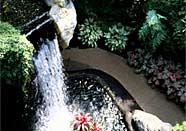|
Frequently Asked Questions About
Plant Health Care
What is Plant Health Care?
Plant Health Care, also called PHC, offers a total
health approach to landscape and plant health.
How PHC Landscape Programs Work
Traditional landscape pest control programs rely
on what are called “cover sprays.” The pest control
sprays offered to the client are based on the company’s knowledge of
common pest problems and control measures in the service area. The
cover spray type, method, and timing are pre-determined by the
company.
The client may have the option to choose from a
number of pest control programs based on the client’s priorities.
Traditional pest control programs are not necessarily obsolete or
“bad” for the environment and may be the best option for clients who
have overriding concerns about program cost or are only concerned
about one specific pest problem.
In contrast, plant health care (PHC) technicians
consider the landscape as a whole when deciding how to best care for
plants. PHC technicians control plant problems through careful
monitoring of the landscape environment. Chemical controls may be
part of the treatment but they are not necessarily used in every
treatment.
The PHC technician maintains landscape plants by:
- evaluating the landscape’s environment;
- noting actual or potential causes of plant
stress (stressors);
- maintaining plant performance through proper
cultural practices;
- investigating the landscape through monitoring;
- and identifying and treating problems as they
occur.
Because of this, every PHC program is “customized”
to fit the client’s property and expectations.
Why is my technician recommending a
Plant Health Care program?
Your technician probably recognized a potential or
actual problem in your landscape that might be best avoided or
treated by implementing a PHC treatment program. The following are
examples of some common problems:
Many plant problems are related to improper
matching of the plant’s requirements to the landscape site.
This is often called “right plant / right site.”
Example of this type of mistake are easy to find, the following is a
common one in the eastern US. Dogwoods thrive in moist, acidic
soils, especially if there is light, partial shade, but they are
often planted in the middle of grass lawns in direct sunlight. Grass
has different requirements than Dogwoods. Grass prefers non-acidic
soils. Lawn care providers often raise the pH with lime to change
the acidity level. The direct sunlight and competition with grass
leads to a drier soil. The dogwood becomes stressed and more
susceptible to plant diseases and insect infestations.
Plants may have been improperly planted.
One common planting mistake is planting too deep.
Planting too deep and other planting mistakes are often the source
of plant problems.
Plants may be subjected to improper maintenance
techniques. Landscapes are often subjected
to improper pruning, fertilizing, irrigation, and other cultural
practices. The following is one common example. Landscapes have a
variety of plants with different nutrient requirements. They are
often given one uniform fertilizing program that doesn’t meet their
individual needs, causing stress to plants not suited to the
fertilization practice.
Stress Complex. Often
a combination of improper plant sighting (wrong plant / wrong site),
improper planting and improper maintenance techniques exist,
compounding the program. These all can cause plant stress and
decline, making the plant more susceptible to plant diseases, pest
infestations and environmental pressures. The combined effects of
different stress agents is often called a stress complex.
The technician said the program
will be customized according to my expectations. What exactly does
that mean?
The whole PHC program is based on you the client
and your need for a healthy, vigorous landscape.
Your Expectations
A PHC technician will consider your expectations
when deciding how to implement a PHC treatment program. One
important question is just when do you, the client, want to resort
to chemical control of pest problems.
Some clients will tolerate a greater percentage of
plant damage before requiring action. Some clients will tolerate
very little plant damage. Often a client will tolerate less damaged
on a prized ornamental specimen tree located in the front yard as
opposed to a group of shade trees growing in the back yard. This
requires the PHC technician to apply a higher action threshold to
some trees and/or sections of the landscape than others.
Here, communication and understanding between the
client and plant health care technician is key!
Treatment recommendations are then made to the
client based on that client’s expectations. The key to a successful
plant health care program is communication between the client and
PHC technician.
Free analysis and price quote
|



